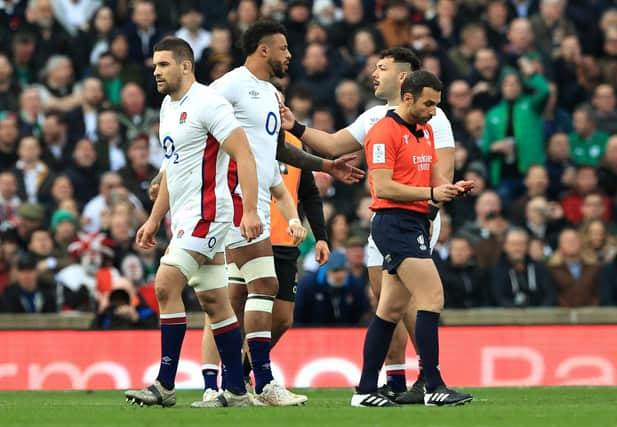Red cards in rugby: Lawmakers must adopt a carrot and stick approach to the problem of dangerous high tackles


On the face of it there is something to be said for the idea. Why should a team suffer for one player’s misdemeanour? Why should spectators and those watching on television be deprived of a fair and equal contest, 15 against 15 ? And when the red card and sending-off occur early in the match – as, for instance, when the English lock Charlie Ewels was sent for a very early bath in the first minute of the Six Nations match against Ireland – didn’t this spoil the enjoyment of all who had paid for a ticket?
All these questions may be answered in the same way: perhaps yes, on the other hand, perhaps no. Of course it’s disappointing for spectators when a match becomes one-sided, and, given that top-level rugby is now a professional game, the old adage that the game is for the players, not spectators, hardly applies. Spectators at the ground and television companies have paid a lot of money. Shouldn’t their interests and requirements be taken into account?
Advertisement
Hide AdAdvertisement
Hide AdWell, yes, up to a point. Nevertheless, the safety of players is a primary consideration. Nobody now doubts that head injuries are dangerous, repeated head injuries often leading to an early onset of dementia. So referees are rightly being severe, and, if some red cards are given for what looks more like carelessness than malice, no matter. The deterrent is aimed at rash and careless tackles too. As to the proposal to allow the dismissed player to be replaced after twenty minutes, well, why shouldn’t his team suffer the consequences of his folly? Isn’t this more likely to persuade coaches and players of the need for self-restraint?
The consequences for any individual match of what happens after a player is given a red card are surely irrelevant to the argument, and not only because they are incalculable. That England-Ireland match turned out to be a cracking good game as the English forwards rallied to overcome their numerical inferiority. It might have been different if they had known they would have a replacement coming on in 20 minutes. There would, one expects, have been a lot of time-wasting.
Red cards will in time change habits and reduce the number of dangerous high tackles. But changes in the Laws may be necessary too.
There was an interesting moment in the Scotland-Ireland game. Pierre Schoeman, carrying the ball high on his chest and protecting it with his left arm ran into Iain Henderson dangerously near the head. The referee and the TMO looked at the replay and decided there was no offence. Meanwhile some Irish fans called for Schoeman to be sent off. It was an Irish writer who, a day or two later, asked a pertinent question – “why was the tall Henderson standing upright?” – and gave the answer: that he had been coached to do so and tackle high in order to prevent the ball-carrier from going to ground. If successful, Ireland would get the put in at a resultant scrum. Henderson, that is to say, was aiming to make the “choke tackle” which has been a feature of the Irish game for years. But this choke tackle will often lead to a dangerous clash of heads.
The laws encourage dangerously high tackles. The classic low tackle, round the hips, thighs, knee or ankle, will often fail to stop a movement because players’ off-loading skills are now so developed. Moreover, even if the player is brought to ground, the attack may continue because the law permits him still to make a pass so long as he does so immediately. This used to be unlawful, passing off the ground being a penalty offence.
If coaches encourage their players to tackle well above the waist in an attempt to prevent the ball-carrier from being able to move the ball, only a revision of the law that will reward tackling below the waist will bring about a change.
In short, the lawmakers must adopt a carrot and stick approach to the problem of dangerous high tackles. The stick is a red card, and that is now in place. But where, one asks, is the bloody carrot? Where the law that encourages the tackle no higher than the waist? Where the law that makes low tackling pay?